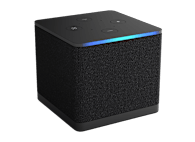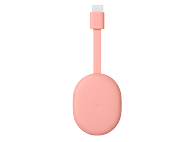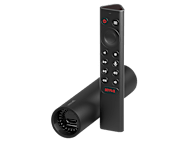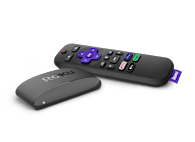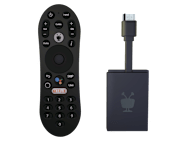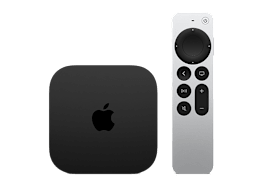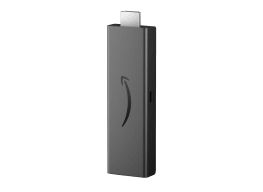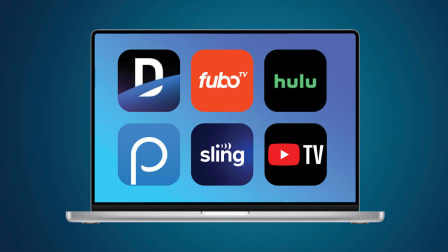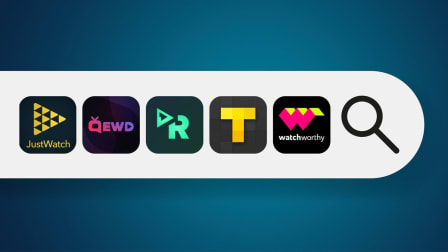Best 4K Streaming Media Devices of 2024
Consumer Reports helps you decide which model from Amazon, Apple, Google, Nvidia, Roku, or TiVo is right for you
When you shop through retailer links on our site, we may earn affiliate commissions. 100% of the fees we collect are used to support our nonprofit mission. Learn more.
Take a look around your house—there’s a good chance you own one or more smart TVs, with the ability to stream TV shows and movies. That’s not surprising. About 63 percent of all U.S. homes with internet access now own a smart TV, according to research firm Parks Associates. In larger screen sizes, it’s getting hard to find a set that isn’t a smart TV model.
However, that still leaves a lot of people who need a streaming device to access online streaming services, from Amazon Prime to YouTube TV. In addition, plenty of us who have smart TVs decide to add a streaming device. In my own home, four of our five smart TVs are connected to either an Amazon Fire TV, an Apple TV, or a Roku streaming player.
These add-on devices might outperform your smart TV’s built-in system, or they might offer features or services you can’t get from that TV. And if your smart TV is a few years old, you might find that the apps for streaming services you use are outdated or missing altogether.
What You’ll Find
The 4K streaming media device market is dominated by just a few software platforms: Amazon Fire TV, Apple TV, Google Chromecast, and Roku. You need to decide on a platform as well as a specific model.
In general, streaming devices are either set-top models or small stick-style players that plug directly into an HDMI slot on the TV. Prices for the devices listed below range from about $30 to $200, and they fluctuate throughout the year, so it pays to look for deals.
The newest 4K models in our streaming media device ratings support high dynamic range (HDR) technology. When done right, HDR boosts a TV’s brightness, contrast, and color, making the pictures on the screen look more like real life. It’s an important feature of the best TVs on the market. All these streaming models support the HDR10 format, and many now also support HLG, which is likely to be used by some “Next Gen TV” broadcasters when they start sending out these new over-the-air TV signals to antennas. More models also support the Dolby Vision and/or HDR10+ formats.
Consumer Reports has now added data privacy and security scores in the ratings for all the streaming devices we test, in addition to attributes such as picture quality and ease of use. We evaluate the various ways brands collect, use, and share consumer data; how well they protect it; and how transparent the companies are about their data practices.
We also judge companies by how they handle security procedures, such as encrypting all user communications by default, enabling automatic security updates, and protecting against known security vulnerabilities.
Consumer Reports is a nonprofit member organization that works to create a fairer, safer marketplace. Like all the products CR tests and rates, we buy our streaming devices at retail outlets, just like you might.
The streaming devices below are listed alphabetically.
This is the third iteration of the 4K-ready Fire TV Cube, essentially a mashup of two of Amazon’s popular Alexa-powered devices, the Fire TV streaming player and the Echo Dot smart speaker. Like its predecessors, this Fire TV Cube adds an interesting element into the mix: universal remote control capability for controlling other audio/video gear. Like earlier models, it has Amazon’s Alexa voice assistant; new features include a faster processor, which upscales lower-resolution content to 4K, HDMI 2.1 connections, and WiFi 6E support. There’s now also an Off button that disconnects the microphones if you don’t want to leave the device in an always-listening mode.
Best for: Amazon Prime subscribers who like the Alexa voice assistant and want to be able to control other components. Amazon tends to prioritize its own content, though, when you’re looking for something to watch. Some people might find that annoying.
This latest stick-style streaming player from Amazon—the Amazon Fire TV Stick 4K Max—is among the company’s fastest, thanks to a more powerful processor, so apps launch quicker than on earlier models. Also, the device includes WiFi 6, the latest version of the wireless protocol. (You’ll need a WiFi 6 router to take advantage of this feature, but the device works with older routers.) This model supports the HDR10, HDR10+, HLG, and Dolby Vision HDR formats, as well as Dolby Atmos audio. It comes with an Alexa voice remote, so you can find, launch, and control content or even change inputs using voice commands.
Best for: Amazon Prime members who own—or expect to get—a WiFi 6 router, and who want a speedy stick-style player.
Apple TV has always made sense for those who already live in Apple’s world, and the new Apple TV 4K is no exception. While the 32-gigabyte version, $129, is less expensive than its predecessor, it remains among the priciest streaming players available. (We tested the 128GB model.) The only real differences between the two are price and storage, and that the 128GB version has an Ethernet jack for a wired connection to your network. Both models have a faster processor and add HDR10+ support in addition to Dolby Vision. (They also support Dolby Atmos 3D sound.) The new Apple TV 4K comes with a redesigned Siri remote that has a clickpad rather than the love-it-or-hate-it touchpad found on some earlier models. A USB-C charging port replaces Apple’s proprietary Lightning connector.
Best for: Those who are already invested in the Apple ecosystem and use iTunes for content—and don’t mind paying a premium for an Apple device. With the Apple TV app now becoming available on more devices, including smart TVs and streaming players, owning an Apple TV may become less important than in the past.
The revamped Google Chromecast is now called Chromecast with Google TV. The player is a 4K model that supports the HDR10, HDR10+, and Dolby Vision HDR formats. The new model comes with a voice remote that has a dedicated button for Google Assistant, the company’s voice-powered digital assistant. Earlier versions lacked a remote control, so you had to use a smartphone or tablet to control the player.
Another change is a home screen that organizes movies and TV shows from all your favorite services in one place, so it’s easier to find what you want to watch. The player is offered in three colors—Snow (white), Sunrise (pink), and Sky (baby blue)—though many retailers are now only offering the white version.
Best for: Anyone who likes the Android TV platform and the ability to control other compatible smart devices. By contrast, the older Chromecast, which required you to use your smartphone, was really best for more tech-savvy users.
The Nvidia Shield TV and the pricier Nvidia Shield TV Pro models both have the same fast processor and artificial intelligence upscaling that will convert lower-resolution content to 4K, plus support for Dolby Vision HDR and Dolby Atmos and DTS:X 3D sound. Both systems’ smarts are based on the Android TV platform. There’s built-in support for the voice-powered Google Assistant, and they will work with Amazon Alexa devices. The Shield has a remote-finder button on the unit, a feature available only via the Shield TV app with the Pro model.
Apart from price, the main differences between the models are related to memory and storage. The Shield TV lacks the two USB slots found on the Pro but has a microUSB card slot for adding storage. It comes with 8 gigabytes of storage and 2GB of memory, rather than the 16GB/3GB in the Pro. Both models have Ethernet jacks for using a connection to your home network.
Best for: Gamers who also want a solid streaming player with a decent number of features and support for several digital voice assistants, but at a price lower than the Shield TV Pro model’s.
The Roku Express 4K+ replaced the Roku Premiere in the company’s lineup. Like that model, the Express 4K+ is a small set-top box that offers 4K picture quality, plus support for both HDR10 and HDR10+ high dynamic range formats, though not Dolby Vision, which is found in some pricier models. The included WiFi voice remote control has TV controls that let you turn on the TV, adjust the set’s volume, and use Roku Voice to launch channels, search for content, and control streaming services. Like other Roku players and TVs, it will work with Amazon Alexa and Google Assistant, as well as Apple AirPlay and HomeKit, so you can use voice commands on devices that include them to control the player.
Best for: Roku fans who prefer a set-top box-style player, and who don’t mind missing out on Dolby Vision.
The Roku Streaming Stick 4K has most of the same features as the more expensive Roku Streaming Stick 4K+ model, including improved WiFi, support for HDR10+ and Dolby Vision HDR, and the ability to work with Amazon Alexa, Apple AirPlay, and Google Assistant voice assistant.
This model comes with a standard Roku remote. You might want to splurge an additional $30 for the Roku Streaming Stick+ model if you’d like to get the more advanced, rechargeable Voice Remote Pro remote control, which has a built-in headphone jack for private listening, programmable buttons, and a lost-remote finder feature.
Best for: Roku fans who want a stick-style player with a lot of features but can do without the Voice Remote Pro to save some money.
Roku has refreshed its flagship Roku Ultra player, though really not much has changed beyond it now coming with Roku’s top-of-the-line remote control, the rechargeable Voice Remote Pro. The set-top-box style is still the fastest Roku, and it’s the only model with an Ethernet jack. Like the earlier model, it has a remote-finder button that causes the remote to beep if you misplace it, a headphone jack in the remote control for private listening, and two programmable shortcut buttons. This model supports Dolby Vision and HDR10+ HDR, plus Dolby Atmos sound. Like other Roku models, the Ultra supports both Amazon Alexa and Google Assistant voice assistants.
Best for: Almost anyone looking for a top-performing player with lots of content and all the bells and whistles a streaming device can include. In general, we like Roku’s agnostic approach to search, which gives you unbiased results from various services because the company doesn’t offer its own paid subscription service.
Known for its top-notch DVRs, TiVo is now taking aim at the Apple TV and Roku models with the TiVo Stream 4K, its first dedicated streamer.
Since its introduction, the price keeps falling, making it a low-priced 4K option for those on a budget. It runs on the Google Android platform, with a proprietary TiVo app for searches and content recommendations. The device supports 4K videos with HDR10, Dolby Vision, and HLG HDR formats. The player, which also supports Dolby Atmos sound, comes with a tiny peanut-shaped TiVo remote, or you can use voice commands with the built-in Google Assistant. One thing we really like about Stream TV is that it integrates content from many of the streaming services you use into a single program guide.
Best for: Budget-minded Android TV fans who like TiVo’s intuitive user interface plus an integrated program guide for most of the services you watch.

















